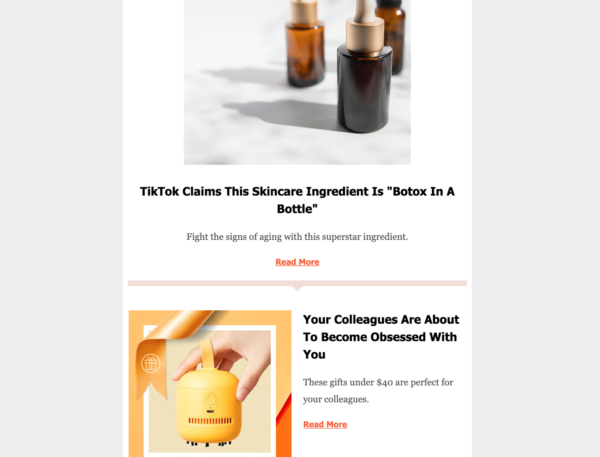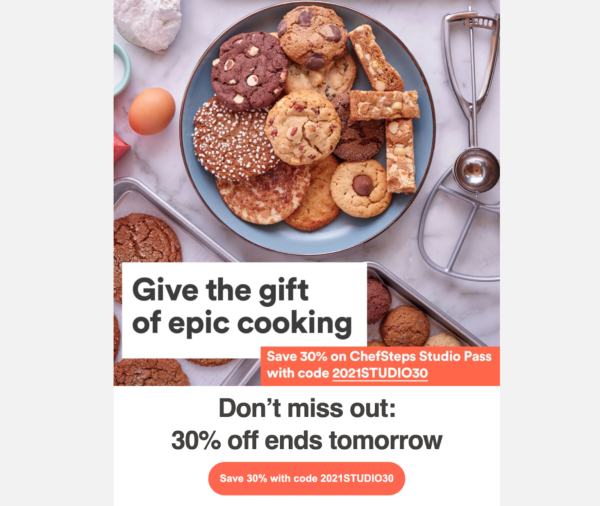
Wondering why it would be important to know how to write a short newsletter?
Think of your own inbox. You try to zero it out, but you feel like you’re playing a game of whack-a-mole. You delete, reply, or file one message, and three more come in. That means that you probably don’t have the time — and definitely don’t have the patience — for long newsletter content that doesn’t immediately engage you.
When crafting your business’s newsletter, keep your content short and sweet. Subscribers should be able to skim and process material almost instantaneously.
Any writer will warn you that brevity is hard. But the payoff is always worth the effort.
These newsletter writing tips will help you retain subscribers and keep your audience reading.
Why you should write a short newsletter
With so much clutter in people’s inboxes, should you bother sending out a newsletter at all? Yes.
Email marketing still yields the highest return on investment (ROI) of any channel — $36 for every dollar spent. Customers want to hear from you, and email is your best bet for reaching them. More than 4 billion people use email.
Newsletter content allows you to stay in touch with your customer base even when you don’t have particular deals or promotions to offer. Keep your brand present in their lives. They may not currently need your goods or services, but they’ll remember you the next time they do.
How to format and choose your newsletter content
The average time that people spend reading a brand email is 10 seconds. That’s not long.
In order to get a better idea of how short that really is, try setting a timer for 10 seconds before reading any further. Then read as much as you can before the timer buzzes. Unless you have special speed-reading skills, you won’t have read very much.
And before people even give you 10 seconds of their precious time, you need them to open the email.
How can you get subscribers to open your newsletter? How can you keep them reading — or, even better, get them to click through to your website?
Newsletter format
Enable readers to scan content and return to what intrigues them.
People are likely to delete anything that isn’t easy to read when and where they want it and about 60% of Constant Contact emails are opened on mobile devices these days. That’s why you need an attractive, mobile-optimized design that breaks up information into easily digested chunks.
Create a branded template that hits the right length and tone. You want readers to instantly identify it as brand communication from a trusted source.
Newsletter subject matter
Choose the best newsletter content for your business. You want to find topics that resonate with your subscribers’ passions and concerns.
Once you have your topics, build reader interest. Craft compelling subject lines for your newsletters. Advertise their relevance and the value they add to a conversation — humor, advice, the latest industry news, and more.
Newsletter length
And we’re back to the key takeaway of this article — keep your newsletter short without sacrificing value or readability. Read on for how to do just that.
How to write a short newsletter
Correction: This section will teach you how to write a short, high-quality newsletter. After all, inadequate content will turn off readers as much as a too-long email. These newsletter writing tips will help you trim the fat in ways that enrich — rather than deplete — content.
1. Get to the point
You don’t have extra time and space to waste building up to your point. Dive right in and immediately tell people the main idea.
There’s an old journalism technique called the inverted pyramid, which requires you to start with the most important information. As you move through the article, the information becomes less and less important. It enhances the story through nuance rather than providing unnecessary details upfront.
Your newsletter is a great place to practice the inverted pyramid. If you have a new store opening, start with: “Our new Roseville location opens on Sunday, August 2nd.” Don’t start with: “When our manager first approached us about expanding our operations, we were skeptical.”

2. Share a little information and link to more
In a newsletter, you often deliver only the first, broadest step of the pyramid.
Tell your story. You want to engage your subscribers with the personality and history of your brand. Just house all of this longer content elsewhere, developing full articles in your blog, podcast, or other channels. Share a teaser of one to two sentences in your newsletter, and then provide links to the longer pieces.
You should include clear calls to action (CTAs) that invite readers to read more or to find related material. Make these links easy to see and use. Big buttons that take you directly to the longer content are ideal.
3. Craft dynamic and informative headlines
Your headline needs to establish the topic and pique the reader’s interest. Every word counts, so you need to make the most of your text. Avoid generic headlines that could apply to any number of businesses or news items.

4. Use multimedia
After all, they say a picture’s worth a thousand words. Pictures also help to break up text, making it easier to read. Include pictures in your newsletter to make content more attractive to readers as well as to help them process information.
Or embrace other media forms with animations that link to video or audio clips. Over 100 million people watch YouTube on their TVs every month and the trend of video marketing shows no sign of slowing down.
5. Make scannable lists
Lists are a great format for newsletter content. That’s because lists can:
- Condense information
- Emphasize important ideas
- Attract readers
- Add variety to the reading experience
- Improve reader understanding
They’re easy to read and quick to scan. They also break up blocks of text and organize content in a way that is both intuitive and visually appealing.
6. Write clean, clear, and concise prose
If you want to learn how to write a short newsletter, you need to learn how to write well. Sloppy writing is both painful to read and inefficient.
When you edit your newsletter, take the following actions:
- Eliminate redundancy. Avoid repeating the same details or phrases, and keep an eye out for words that mean the same thing. You don’t want to produce wordy pieces.
- Use clear language. Jargon often leads writers into convoluted sentences that they struggle to complete. It will alienate some of your readers because not everyone understands it.
- Use the active voice most of the time. It’s more efficient and more dynamic. It also forces you to identify the agent of the action, adding clarity. Compare: “The newsletter was written” (passive voice) vs. “Jane wrote the newsletter” (active voice).
- Edit wordy sentences. Don’t add unnecessary words to your sentences.
First write, then revise
You’re convinced. Shorter is better. A brief newsletter will serve you better than a rambling one. And you’re ready — ready to integrate lists and animation, ready to craft compelling headlines and CTAs, and ready to prune your writing of excess language and detail.
But writing newsletter content that’s concise, focused, and rich is not always easy. Most writing is rewriting. Start by writing a rough draft of your next newsletter. Then go back through it and ruthlessly edit, using these tips to guide you. Soon, you’ll be writing short newsletters like a pro.




